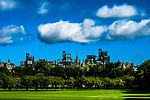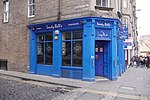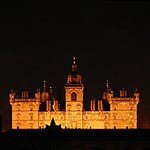Edinburgh Futures Institute

The Edinburgh Futures Institute (EFI) at the University of Edinburgh is an interdisciplinary unit within the College of Arts, Humanities and Social Sciences. Opened in 2022, the EFI links arts, humanities, and social sciences with other disciplines in the research and teaching of complex, multi-stakeholder societal challenges and data-driven solutions. The institute offers undergraduate and postgraduate degrees in interdisciplinary subjects such as Data and Artificial Intelligence Ethics; Future Governance; and Planetary Health. The EFI is housed in the Category-A listed former Royal Infirmary of Edinburgh at Lauriston Place, at the southern edge of Edinburgh's Old Town. As of 2024, it is led by Interim Director Kev Dhaliwal, Professor of Molecular Imaging and Healthcare Technology.
Excerpt from the Wikipedia article Edinburgh Futures Institute (License: CC BY-SA 3.0, Authors, Images).Edinburgh Futures Institute
Lauriston Place, City of Edinburgh Tollcross
Geographical coordinates (GPS) Address External links Nearby Places Show on map
Geographical coordinates (GPS)
| Latitude | Longitude |
|---|---|
| N 55.9445 ° | E -3.1927 ° |
Address
Edinburgh Futures Institute
Lauriston Place
EH3 9EF City of Edinburgh, Tollcross
Scotland, United Kingdom
Open on Google Maps






